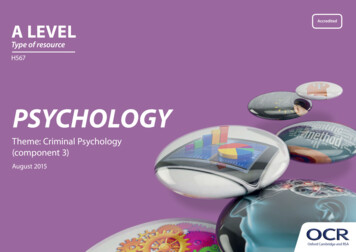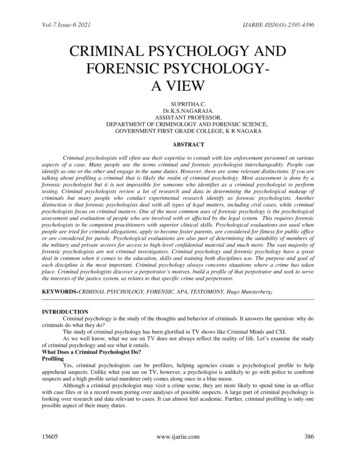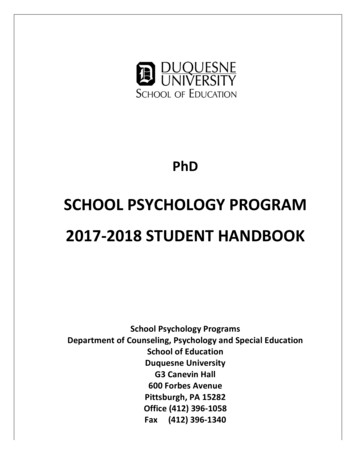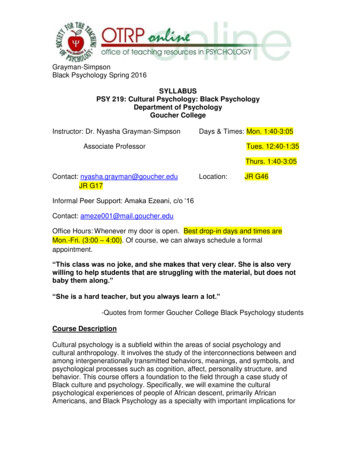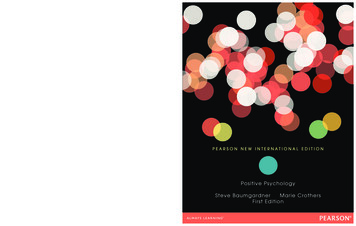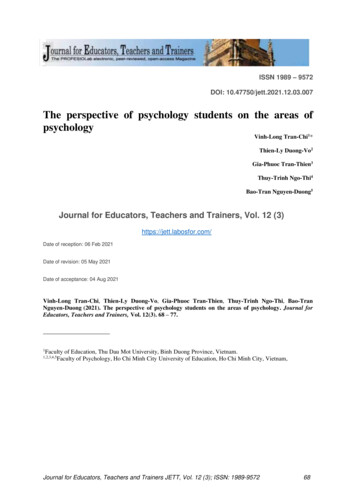
Transcription
ISSN 1989 – 9572DOI: 10.47750/jett.2021.12.03.007The perspective of psychology students on the areas ofpsychologyVinh-Long Tran-Chi1*Thien-Ly Duong-Vo2Gia-Phuoc Tran-Thien3Thuy-Trinh Ngo-Thi4Bao-Tran Nguyen-Duong5Journal for Educators, Teachers and Trainers, Vol. 12 (3)https://jett.labosfor.com/Date of reception: 06 Feb 2021Date of revision: 05 May 2021Date of acceptance: 04 Aug 2021Vinh-Long Tran-Chi, Thien-Ly Duong-Vo, Gia-Phuoc Tran-Thien, Thuy-Trinh Ngo-Thi, Bao-TranNguyen-Duong (2021). The perspective of psychology students on the areas of psychology. Journal forEducators, Teachers and Trainers, Vol. 12(3). 68 – 77.1Faculty of Education, Thu Dau Mot University, Binh Duong Province, Vietnam.Faculty of Psychology, Ho Chi Minh City University of Education, Ho Chi Minh City, Vietnam,1,2,3,4,5Journal for Educators, Teachers and Trainers JETT, Vol. 12 (3); ISSN: 1989-957268
Journal for Educators, Teachers and Trainers, Vol. 12 (3)ISSN 1989 – 9572https://jett.labosfor.com/The perspective of psychology students on the areas of psychologyVinh-Long Tran-Chi1*, Thien-Ly Duong-Vo2, Gia-Phuoc Tran-Thien3, Thuy-Trinh Ngo-Thi4, Bao-TranNguyen-Duong51Faculty of Education, Thu Dau Mot University, Binh Duong Province, Vietnam.1,2,3,4,5Faculty of Psychology, Ho Chi Minh City University of Education, Ho Chi Minh City, Vietnam,*Corresponding l.com, thuytrinhgeirlys@gmail.com, baotranpsy@gmail.comABSTRACTPerception is defined as the result of an awareness process about phenomena, things (living animals,plants, or humans), connections between objects by activities including noticing, observing,differentiating, and acknowledging. A recent study was conducted to investigate the undergraduate’sperception of areas of psychology. This research used the Vietnamese version of the Scale of Interestsby Areas of Psychology (EIAPsi) including ten subscales to survey 252 psychology students (57 malesand 195 females) from four universities in Vietnam. The findings showed significant effects ofuniversity and major on psychology undergraduate’s perception of areas of psychology. Studentsmajoring in Counseling and Clinical Psychology had more general knowledge about the functions androles of Clinical and Health Psychology and Neuropsychology than other undergraduates. Industrialand Organizational Psychology students had more general knowledge about OrganizationalPsychology than students in other majors.Keywords: perspective, undergraduate, psychology, major, VietnameseINTRODUCTIONThe time that people are living in is called the era of industrial revolution which is characterized by a high fusionof physical and digital hyper connected systems with a particular emphasis on Internet, Technology, Science orArtificial Intelligence (AI). Technology is becoming more and more advanced; humans can access a wide varietyof data applications and social networking sites. This leads to the transformation of individuals as people have tochange themselves in order to open the knowledge horizons and adapt to the technology context. Consequently,human psychology has many fluctuations which resulted in the highly developed Psychology. It was born toexplain issues that technology could not, which is becoming an internal science by its peculiarities. PsychologicalScience is creating interventions that improve people’s lives in various spheres, particularly, enhancingeducational achievements, enriching work life (Clay, November 2017). Besides, according to AmericanPsychological Association, Psychology is defined as a variety of scientific disciplines including numerous mainfields of research such as cognitive, biological, personality, developmental, social, experimental. Kalat (2021)stated that Psychology is also a systematic research of the way that people behave and the things that havehappened to individuals that influence the way they think and behave on sensation and perception, learning andmemory, hunger and thirst. The study of human behavior, cognition, emotion, and motivation is known aspsychology, which has a long tradition and can be subdivided into many different specializations such as clinical,industrial/organizational, neuropsychology, educational, health (APA, 2020c). Kuther (2019) classifiedPsychology into several subfields comprising behavior neuroscience, clinical psychology, cognitive psychology,community psychology, counseling psychology, developmental psychology, educational psychology,experimental psychology, forensic psychology, health psychology, human factors psychology, industrialorganizational psychology, school psychology and social psychology.Owing to the development of psychological science, Psychology has been a tendency of academic discipline instudents. This field is extremely popular in college, numerous students have chosen Psychology as their major forfuture career options. According to the estimation, there were between 1.2 million and 1.6 million undergraduatestudents enrolling in introductory psychology classes each year (Gurung et al., 2016). Similar to business, healthprofession associated programs, social science and history, Psychology has been reported to take the 4th place inthe most prevalent individual specialties in general based on the statistics of the United State Department ofEducation (Clay, November 2017). For a developing nation like Vietnam, the pressure of work productivity, lifestandard, individual development and individual outcome has become the main causes of mental health, therefore,Journal for Educators, Teachers and Trainers JETT, Vol. 12 (3); ISSN: 1989-957269
Vietnam society has needed a number of expertise who can help people reduce problems related to mental health.Meanwhile, Psychology has been a new discipline in higher education leading to the extremely scarce humanresource. This is the reason why young people tend to choose Psychology as a major. Due to the novelty of thisacademic discipline, students learning Psychology have fallen under the umbrella of many challenges andobstacles such as lack of major documents, being good at statistics, having fluent science language or gainingmedical knowledge. Conversely, Psychology also brings several benefits for students studying it including: (i)becoming a psychological consultant, (ii) becoming a lecturer, (iii) becoming a person is able to help peopleinterpreting and balancing their initial emotions and psychological problems, (iv) gaining understanding andability to work with people effectively in other subfields of Psychology. Because of aforementioned benefits,more and more students have been interested in learning Psychology which resulted in deciding Psychology as anacademic major. The interest in selecting Psychology as a discipline of undergraduate students in IllinoisUniversity dramatically grew from 1925 to 1944 (Fischer & Hinshaw, 1946). Until now, there are 17 universitieswhich enroll students in Psychology in Vietnam. In 2020, more than 900 students applied and entered theDepartment of Psychology in Vietnam universities (excluding overseas students). Bott, Stuhlmacher, and Powaser(2006) reported an increasing interest in Industrial and Organizational psychology among undergraduate students.Specifically, most of the survey participants offered one or more courses related to Industrial/Organizationalpsychology in learning programs such as Introduction to Industrial and Organizational psychology,Psychometrics/Measurement, and Independent Study. From 1975, the number of Industrial/Organizational andcounseling psychology courses increased substantially and were in the top 30 areas of psychology which weremost frequently required at the undergraduate level (Perlman & McCann, 1999). Another study showed thatundergraduate psychology students had more interest in clinical and counseling psychology when learning andgetting the greater knowledge about clinical and counseling psychology than other areas (Stark-Wroblewski,Wiggins, & Ryan, 2006).There have been numerous studies focusing on student’s perception of psychology for decades. According toAmerican Psychology Association Dictionary, perception is defined as the result of an awareness process aboutphenomena, things (living animal, plant, or human), connections between objects by activities including noticing,observing, differentiating and acknowledging (APA, 2020b). Organisms could arrange the information andinterpret the stimulation received from the environment into useful knowledge and to act in a systematic waywithout interruption or difficulty with these activities. Efron (1969) considered perception as a fundamental formof cognitive interaction with the natural environment and the world. Morales, Abramson, Nain, Junior, andBartoszeck (2005) conducted a research with 190 Brazilian undergraduate students, survey participants andshowed that more than half of undergraduates considered psychology a science. Specifically, undergraduatesagreed that psychology could be in the same category as natural science and psychology courses were necessaryfor university education. These findings supported previous studies of Wood, Jones, and Benjamin (1986) andMcGuire and Borowy (1979). Bartels, Hinds, Glass, and Ryan (2009) revealed a positive effect of the number ofpsychology courses on undergraduate student’s perception of psychology. The authors indicated that students whoparticipated in four or more psychology courses would have stronger perceptions of psychology as a science.However, Gardner and Dalsing (1986) reported that students had lots of misconceptions about the areas ofpsychology when entering college and those false beliefs which are affected by parents and incorrect informationfrom the media still existed after participating in some psychology courses. Besides, Malin and Timmreck (1979)surveyed 418 psychology students and showed that most of them wanted to learn clinical psychology orcounseling for achieving career goals. Moreover, the authors reported that three main reasons for pursuingpsychology include (i) hoping to have a psychology-related or closely related career; (ii) taking pleasure in takingpsychology courses; (iii) understanding of themselves and other people.To the best of my knowledge, there are few studies investigating the student’s perception of areas of psychologyin Vietnamese educational context for the past few years. To bridge this gap, our study is conducted to examinethe psychology undergraduates’ perception of areas of psychology. The research starts with the literature reviewof student’s perception of psychology. The methodology is shown in the following sections. Then, the researchresults and discussion are respectively reported. The last is the conclusion with contributions from the study.METHODResearch hypothesesA 4 3 factorial design was used. The independent variables were: University (HCMUE - Ho Chi Minh CityUniversity of Education, HUTECH - Ho Chi Minh City University of Technology, UED - University of Scienceand Education, University of Danang, and ULSA - University of Labour and Social Affairs) and Major(Industrial/Organizational Psychology; Counseling and Clinical Psychology, and Educational Psychology). Tendependent variables were measured: Clinical and Health, Sport, Teaching and Research, Educational, Legal,Neuropsychology, Organizational, Psychodiagnosis, Social, and Traffic. The null hypotheses that were testedwere as follows:Journal for Educators, Teachers and Trainers JETT, Vol. 12 (3); ISSN: 1989-957270
H01 (main effect): There is no significant difference among four study groups of university when they arecompared simultaneously on ten factors.H02 (main effect): There is no significant difference among three study groups of major when they are comparedsimultaneously on ten factors.H03 (interaction effect): There is no significant interaction between university and major when they are comparedsimultaneously on ten factors.ParticipantsAn online survey was conducted, and 252 responses were collected fully valid. Among 252 psychology students,57 (22.6%) were male and 195 (77.4%) were female. There were 75 students majoring in Industrial/OrganizationalPsychology, 69 majoring in Educational Psychology, and 108 majoring in Counseling and Clinical Psychology.All the distributions of participants were shown in Figure 1.Fig.1: Percentage of 252 participants in gender and major.Data Collection ToolsThe 90 items of EIAPsi were translated into Vietnamese by two bilingual researchers. One of them is a Vietnamesenative speaker who is fluent in English. The other one speak English as the first language and be fluent inVietnamese. Forward and backward translation procedures were conducted following the guidelines. The initialorder of items was unchanged in the Vietnamese version of the 90-item EIAPsi. All survey participants wereasked to read the questionnaire carefully and choose the answers which most described them.First, participants completed social-demographic questions. Then, they were asked to answer the Vietnameseversion of the Scale of Interests by Areas of Psychology (EIAPsi) based on the Portuguese version of Ambiel etal. (2020). According to Ambiel et al. (2020), EIAPsi assesses the interests of Psychology students regarding thedifferent areas of the profession. The questionnaire included 90 items, divided into ten factors (known as ten areasof psychology), which are: Clinical and Health, Sport, Teaching and Research, Educational, Legal,Neuropsychology, Organizational, Psychodiagnosis, Social, and Traffic. We decided to use all ten factors (90items): Clinical and Health (15 items), Sport (8 items), Teaching and Research (14 items), Educational (9 items),Legal (7 items), Neuropsychology (7 items), Organizational (12 items), Psychodiagnosis (8 items), Social (5items), and Traffic (5 items) to examine students’ perception in this study. The participants answered at fivedifferent stages of interest on a 5-point Likert scale (Croasmun & Ostrom, 2011). In this current study, the highestCronbach’s Alpha score was .930 for Clinical and Health factor, and the lowest was .699 for Social factor.AnalysesThe Social Sciences Statistics Program (SPSS) version 22 was used for data processing. First, descriptive statisticswere used to describe the student’s perception of ten areas of psychology. The coding procedure was performedas follows: 1 Not at all interested, 2 Not very interested, 3 Neutral, 4 Somewhat interested, 5 Veryinterested. To set up the group boundary value for outcome discussions, the interval width of the 5-Likert scaleshould be computed (Malhotra, Nunan & Birks, 2017). Based on the above interval width, which is judged asfollows, group boundary values are built to assist in the discussion of research findings: 1.00 - 1.80 Not at all interested 1.81 - 2.60 Not very interested 2.61 - 3.40 Neutral 3.41 - 4.20 Somewhat interested 4.21 - 5.00 Very interestedThen, Multivariate Analysis of Variance (MANOVA) was used to analyze the difference between university andmajor.Journal for Educators, Teachers and Trainers JETT, Vol. 12 (3); ISSN: 1989-957271
RESULTSDescriptive AnalysisThe participants scored in the average range on the scale of EIAPsi. The mean scores, listed from the highest tolowest score, are as below: Psychodiagnosis (M 3.61, SD .63), Clinical and Health (M 3.60, SD .64),Educational (M 3.58, SD .64), Neuropsychology (M 3.57, SD .64), Social (M 3.54, SD .59),Organizational (M 3.53, SD .64), Sport (M 3.44, SD .69), Teaching and Research (M 3.40, SD .62),Legal (M 3.31, SD .71), and Traffic (M 3.31, SD .77). Table 2 presents reliability and descriptive statisticsof ten dependent variables.Table 1: Cronbach’s Alpha and Descriptive Statistics of ten factors.No. itemsαMSDClinical and Health15.9303.60.64Sport8.8943.44.69Teaching and 6993.54.59Traffic5.8333.31.77No. items: Number of items; α: Cronbach’s Alpha; M: Mean; SD: Standard Deviation.Inferential AnalysisA multivariate analysis of variance (MANOVA) was performed with university and major as the independentvariable and the ten subscales of EIAPsi as the dependent variables.The multivariate homogeneity of variance-covariance matrices tested with Box’s M test revealed that the M valueof 1113.656 was significant (p 0.05) based on Huberty and Petoskey’s guideline (Huberty & Petoskey, 2000).Therefore, the assumption of multivariate homogeneity of covariance matrices was not satisfied. As a result,Pillai's Trace value - a more robust statistic, was used in order to report the result.Based on the significant effects found from the MANOVA, a separate two-way univariate analysis of variance(ANOVA) for each of the dependent variables was conducted. In order to perform a series of follow-up ANOVAs,the homogeneity of variance assumption was tested for three subscales. If Levene’s test is significant, this meansthat the assumption has not been satisfied. Based on a series of Levene's Test of Equality of Error Variances, thehomogeneity of variance assumption was satisfied, even though one of the three Levene’s F tests were statisticallysignificant (p .05). In this study, the value of Levene’s test was non-significant for all dependent variables:Clinical and Health, F(11, 240) .1.002, p .445; Sport, F(11, 240) 1.205, p .284; Teaching and Research, F(11, 240) .756, p .683; Educational, F(11, 240) 1.173, p .307; Legal, F(11, 240) .678, p .759; Neuropsychology, F(11,240) 1.286, p .233; Organizational, F(11, 240) 1.631, p .091; Psychodiagnosis, F(11, 240) .752, p .688; Social,F(11, 240) .907, p .534; and Traffic, F(11, 240) .908, p .534.Table 3: Combined Univariate ANOVA TableSourceCorrectedModelUniversityDependent VariableClinical and ficClinical and HealthSportTeachingandResearchType III Sum 793.999.008.048Journal for Educators, Teachers and Trainers JETT, Vol. 12 (3); ISSN: 1989-957272
nosisSocialTrafficClinical and ficClinical and ficClinical and ficClinical and ficClinical and 2251103.651124.905103.306251251251Journal for Educators, Teachers and Trainers JETT, Vol. 12 (3); ISSN: 1989-957273
OrganizationalPsychodiagnosisSocialTraffica. R2 .147 (Adjusted R2 .108)b. R2 .071 (Adjusted R2 .028)c. R2 .079 (Adjusted R2 .037)d. R2 .158 (Adjusted R2 .119)e. R2 .074 (Adjusted R2 .032)f. R2 .150 (Adjusted R2 .112)g. R2 .151 (Adjusted R2 .112)h. R2 .092 (Adjusted R2 .050)i. R2 .067 (Adjusted R2 .024)j. R2 .082 (Adjusted R2 .040)104.03798.87787.274128.724251251251251There was a significant difference in the perception of areas of psychology between students from universitieswhen considered jointly on the ten variables, Pillai’s Trace value .200; F (30, 699) 1.667, p .015, partial η2 .067. Based on this result, the first hypothesis (H01) was rejected. A separate ANOVA was conducted for eachdependent variable, with each ANOVA evaluated at an alpha level of 0.005 (i.e., 0.05/10).There was a significant difference between universities on Educational, F(3, 240) 5.716, p .001, partial η2 .067,with HUTECH (M 3.90, SD .12) scoring higher than ULSA (M 3.73, SD .10), UED (M 3.54, SD .06), and HCMUE (M 3.34, SD .10).There was a significant difference between universities on Organizational, F(3, 240) 4.794, p .003, partial η2 .057, with HUTECH (M 3.78, SD .13) scoring higher than ULSA (M 3.74, SD .10), UED (M 3.49, SD .06), and HCMUE (M 3.33, SD .09).There was not a significant difference between universities when considered jointly on Clinical and Health, F(3,22240) 2.423, p .067, partial η .029; Sport, F(3, 240) 3.139, p .026, partial η .038; Teaching and Research,2F(3, 240) 3.999, p .008, partial η .048; Legal, F(3, 240) 3.879, p .010, partial η2 .046; Neuropsychology,F(3, 240) 2.860, p .038, partial η2 .035; Psychodiagnosis, F(3, 240) 1.812, p .146, partial η2 .022; Social,F(3, 240) 2.853, p .038, partial η2 .034; and Traffic, F(3, 240) 3.350, p .020, partial η2 .040.There was a significant difference in the perception of areas of psychology between majors when consideredjointly on the ten variables, Pillai’s Trace value .544; F(20, 464) 8.677, p .001, partial η2 .272. Based on thisresult, the second hypothesis (H02) was rejected. A separate ANOVA was conducted for each dependent variable,with each ANOVA evaluated at an alpha level of 0.005 (i.e., 0.05/10).There was a significant difference between majors on Clinical and Health, F (2, 240) 10.312, p .001, partial η2 .079, with Counseling and Clinical Psychology students (M 3.83, SD .06) scoring higher than EducationalPsychology students (M 3.53, SD .10), and Industrial/Organizational Psychology students (M 3.39, SD .08).There was a significant difference between majors on Educational, F (2, 240) 7.352, p .001, partial η2 .058,with Educational Psychology students (M 3.91, SD .10) scoring higher than Counseling and ClinicalPsychology students (M 3.55, SD .06), and Industrial/Organizational Psychology students (M 3.43, SD .08).There was a significant difference between majors on Neuropsychology, F (2, 240) 9.043, p .001, partial η2 .070, with Counseling and Clinical Psychology students (M 3.79, SD .06) scoring higher than EducationalPsychology students (M 3.58, SD .10), and Industrial/Organizational Psychology students (M 3.36, SD .08).There was a significant difference between majors on Organizational, F (2, 240) 8.872, p .001, partial η2 .069,with Industrial/Organizational Psychology students (M 3.78, SD .08) scoring higher than EducationalPsychology students (M 3.62, SD .10), and Counseling and Clinical Psychology students (M 3.36, SD .06).And there was not a significant difference between majors when considered jointly on Sport, F (2, 240) .305, p .737, partial η2 .003; Teaching and Research, F(2, 240) 3.093, p .047, partial η2 .025; Legal, F(2, 240) .719,p .488, partial η2 .006; Psychodiagnosis, F(2, 240) 3.989, p .020, partial η2 .032; Social, F(2, 240) .878, p .417, partial η2 .007; and Traffic, F(2, 240) .713, p .491, partial η2 .006.There was a significant multivariate effect for interaction between universities and majors when considered jointlyon the ten variables, Pillai’s Trace value .432; F(60, 1416) 1.831, p .001, partial η2 .072. Based on the result,the second hypothesis (H03) was rejected. A separate ANOVA was conducted for each dependent variable, witheach ANOVA evaluated at an alpha level of 0.005 (i.e., 0.05/10). The results found that there was not a significantJournal for Educators, Teachers and Trainers JETT, Vol. 12 (3); ISSN: 1989-957274
difference between universities and majors when jointly on Clinical and Health, F (6, 240) .989, p .433, partialη2 .024; Sport, F(6, 240) 1.049, p .395, partial η2 .026; Teaching and Research, F(6, 240) .532, p .784,partial η2 .013; Educational, F(6, 240) 1.231, p .291, partial η2 .030; Legal, F(6, 240) .792, p .577, partialη2 .019; Neuropsychology, F(6, 240) 1.630, p .140, partial η2 .039; Organizational, F(6, 240) 2.456, p .025,partial η2 .058; Psychodiagnosis, F(6, 240) 1.126, p .348, partial η2 .027; Social, F(6, 240) .751, p .609,partial η2 .018; and Traffic, F(6, 240) 1.117, p .353, partial η2 .027.DISCUSSIONThe recent study was conducted to investigate the perception of areas of psychology among VietnamesePsychology students. This research indicated significant effects of university and major when they are comparedsimultaneously on Clinical and Health, Neuropsychology, Organizational and Educational. However, there wasno interaction between university and major of psychology students when they are compared simultaneously onten subscales.The result proved that students majoring in Counseling and Clinical Psychology had more interest and generalknowledge about the functions and roles of Clinical and Health Psychology and Neuropsychology than otherundergraduates. Specifically, most of these students knew that they could (i) relieve psychotherapeutic care inprivate practices or clinics; (ii) promote the psychosocial rehabilitation of people with mental disorder such asdepression; (iii) realize psychotherapeutic care with individuals, couples, families and groups; and (iv) assistpeople who have gone through a major disaster. This finding showed that students considered carefully beforedeciding to major in this field of psychology to achieve career goals in the future. Therefore, they were stillinterested in studying and broadening knowledge about Clinical and Health, and Neuropsychology after takingpsychology courses. In a study, Stark-Wroblewski et al. (2006) reported that undergraduate psychology studentshad more interest in clinical and counseling psychology when learning and getting the greater knowledge aboutclinical and counseling psychology than other areas. The useful knowledge of Clinical and Health Psychologyand Neuropsychology could interpret the great perceptions and interest in these areas of Counseling and ClinicalPsychology students. Neuropsychology studies on the relationship between brain and individuals’ behaviour andthe effects of brain functions on human behaviour and problem related (Plante, 2010). When participating incourses related to Clinical Psychology, undergraduates could integrate and apply empirical scientific knowledgeto diagnose, alleviate illness and disability, and promote individuals’ abilities in growing, adjusting and adaptingto different conditions in the future (APA, 2016). Besides, professional knowledge about Health Psychology couldassist undergraduates in understanding the etiology of symptoms, boost and maintain mental health (APA, 2008).In Psychology’s learning process, students ought to build a solid theoretical foundation of Psychology beforestudying in their major. Because of this reason, they have to take introductory psychology classes with severalsubjects in other areas of Psychology. Although Psychology students had knowledge of each area of Psychology,the result of our findings found that students majoring in Educational Psychology had more general knowledgeabout the functions and roles of Educational Psychology than other undergraduates. According to AmericanPsychology Association Dictionary, Educational Psychology is a domain of Psychology relating to the practicaluse of psychological principles and theories to a variety of educating and learning issues in educational contexts(APA, 2020a). This psychological discipline deals with psychological issues that can occur in pedagogy (Gordon,1917). Besides, studying Educational Psychology could help students gain their academic knowledge horizon inthis major. Particularly, it assists students in comprehending their development; supply strategies to improve theacademic quality and motivational effectiveness; direct the comprehending of the way learners learn and the effectof teaching skills (Duchesne & McMaugh, 2018). Educational Psychology is the most crucial domain of appliedpsychology which researches the psychological elements and problems in education; it encompasses humandevelopment with overall psychological facts associated with the adaptation in the behavior of humans,psychological methods of education, assessment abilities and interests and other issues in Educational Psychology(Aggarwal, 2014). This could be interpreted that students studying this domain had strong interests in their majorleading to spending more time on acquiring and broadening knowledge. Consequently, students majoring inEducational Psychology had more perception of Educational Psychology compared to stud
McGuire and Borowy (1979). Bartels, Hinds, Glass, and Ryan (2009) revealed a positive effect of the number of psychology courses on undergraduate student's perception of psychology. The authors indicated that students who participated in four or more psychology courses would have stronger perceptions of psychology as a science.





